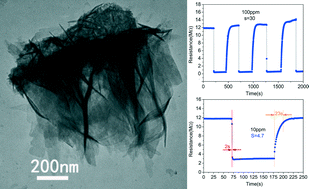Enhanced acetone gas sensing properties by aurelia-like SnO2 micro-nanostructures
Abstract
In this research, well defined, three-dimensional, aurelia-like tin dioxide (SnO2) micro-nanostructures have been successfully obtained using a simple and easy one-step, low temperature, hydrothermal strategy in the presence of cetyltrimethylammonium bromide and poly(vinylpyrrolidone). The use of these SnO2 nanostructures was further developed for use in acetone gas detection. The unique structure and morphology of the SnO2 nanostructures were comprehensively characterized using techniques such as X-ray diffraction, scanning electron microscopy, transmission electron microscopy (TEM) and high-resolution TEM. The results revealed that the aurelia-like SnO2 micro-nanostructures were composed of two parts: the crown and tentacles. The crown and tentacles were assembled from a chassis of mass stunted, disorderly, cumulate nanosheets and a large number of curvy, uneven nanobelts, respectively. The special aurelia-like structure of the SnO2 micro-nanostructures endows the nanostructure-based sensors with enhanced acetone gas sensing performance such as a fast response time (2 s)/recovery time (23 s), high sensitivity, good repeatability and good sensing selectivity at lower working temperatures. The possible formation growth mechanism of the aurelia-like micro-nanostructures and a morphology dependent sensing mechanism are proposed.


 Please wait while we load your content...
Please wait while we load your content...